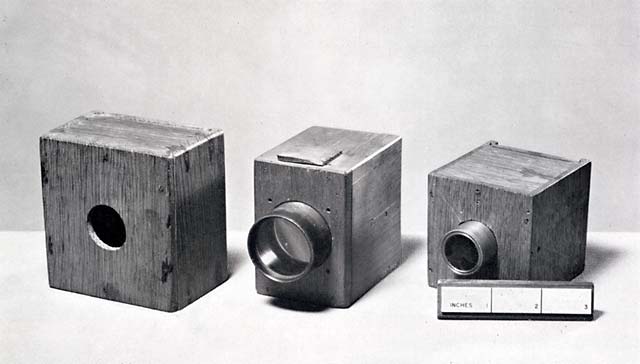In the Beginning...
 |
| Cameras that Fox Talbot used. |
 |
| 1839 Daguerreotype camera. |
In 1839, two viable processes for photography are announced. The Daguerreotype and the Talbotype, the former was better marketed and would dominate for decades. A version of the latter would evolve into that position afterwards. The cameras were not small (see above). One was required to know something about chemistry (all chemicals had to be mixed from scratch). There were no enlargements (paper prints were via contact) but the results had tremendous detail as a result. These parameters dominated the aesthetics, and in part, do so to this day.
It was also expensive. As a result, early photographers tended to be landed gentry/elites. The success of the commercial photographic portrait spread the technology to lower classes, but it still remained out of reach for the common man.
These portraits were made in studios, and the cameras were designed with that environment (and working methodology) in mind. They are used outside the studio, but remain large, complex, expensive and are usually accompanied by portable darkrooms when afield.
By the turn of the century, a wide variety of camera designs proliferated, but they remained large, and the process still technical and out of reach for most amateurs. The landscape photographers used very large format cameras, but the rise of photo-journalism would begin scaling the size of cameras down.
In 1888, Kodak brings out the first camera available to amateurs. In an al rondo format, and with a 100 shot roll, you snap, and Kodak does the rest (via snail mail). Instantly, photography becomes a social rage in the US. "Snappers" are everywhere and photographing everything. They are eventually considered pests, and jokes and cartoons appear about them.

The small cameras are looked down upon and considered toys by the old guard.
Fast forward to 1913...films are faster, and view cameras are shrinking into what will become the Speed Graphic, with a 2 1/4 x 3 1/4 format. This camera is designed for journalists, is handholdable and very flexible in use. It was made until 1973 (!!!!).
The smaller cameras are looked down upon by the old guard.
By 1928, the first successful medium format (2 1/4 x 2 1/4) twins lens reflext enters the market and is soon adopted by prosumers, professionals and amateurs.
The smaller cameras are looked down upon by the old guard.
An inventor named Oskar Barnack had dreams of becoming a landscape painter, but in his 20s, suffering from asthma, he conceived the Ur- Leica, a very small, jacket-pocketable camera to take with him while convalescing in the mountains. The 35mm format 1x1.5 in. takes off.
The smaller cameras are looked down upon by the old guard.
35mm SLRs followed.
Digtal cameras came in...
They were looked down upon by the old guard.
DSLRs followed...
Cell phone cameras came in...and guess what? The Old Guard looks down upon them. The path of technology all along has been towards smaller, lighter, portable, less in-the-way cameras. Those adhering to older technology (which has its uses, btw) will bemoan the new. This ALWAYS happens.
We are seeing a replay of the mania that happened with the first Kodaks in the late 1800s. The miniaturization of cameras will continue. Quality will improve beyond expectations. The technology involving computers is (unlike chemistry) a common one today. The medium continues to democratize itself.
--- Luis
In 1928
Nice brief history, I always think of early camera obscuras and the Greek philosophers as the earliest photographers!
ReplyDelete